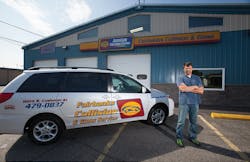In his 32 years in the auto industry, Scott Tompkins has had to fire more than a few employees. Yet, the Alaskan shop owner has a clear conscience about it.
“I’ve never fired a single employee that didn’t know it was coming,” explains Tompkins, the owner of Fairbanks Collision. “When I let them go, I say, ‘You had to see this coming,’ and all of them acknowledge it.
“And I have peace in that.”
Of course, like any longtime shop owner, Tompkins has learned some difficult lessons throughout his career. In fact, the firing process itself has taught him plenty. When FenderBender spoke with Tompkins for a 2013 article, for instance, he had recently parted ways with an estimator who had been a valued friend (fenderbender.com/cuttingties).
While it was excruciating at the time to fire a family friend, Tompkins eventually took solace in the fact that his business improved after the firing, as closing ratios promptly rose from around 50 percent to 80 percent.
Tompkins, whose facility currently boasts a 96.6 percent CSI score and an annual revenue of $3.1 million, has several suggestions for how shop owners can view the firing process with less trepidation. Those tips include the following:
Re-examine your hiring process.
These days, before Tompkins hires any employee, he tries to gauge the following: Does the worker have a history of caring for their job? And, are they trustworthy?
He revisits those questions when determining whether it’s appropriate to fire an employee, too.
The process seems to work, judging by the fact that several members of Fairbanks Collision’s 14-person staff have been with the shop for over a decade. In fact, Tompkins hasn’t had to hire a new estimator since the aforementioned firing in 2013.
“I don’t have a high turnover rate,” he says, “and I attribute it to the hiring process. If I don’t think they’re a fit, I just flat-out don’t hire them.”
Listen to customer feedback.
Sometimes, Tompkins notes, shop owners need to listen to their customers and evaluate why they may have given a repair facility a poor review. The bottom line, he notes, is that body shops like his, which relies on DRP work, can’t afford poor CSI scores that might cost them future work.
That’s why, if Fairbanks Collision ever receives a less-than-ideal review, Tompkins immediately analyzes what went wrong with employees like estimators.
“We’re in a customer service industry, first and foremost,” says Tompkins, whose shop currently has an 86 percent closing ratio. Customers’ “second-largest investment, behind their house, is sitting here broken; they need to be reassured that we’re going to do everything we can to take care of them.
“How we treat customers, that’s what drives our future business.”
Provide advance warning.
Tompkins rarely gives struggling employees an ultimatum. Instead, he attempts to show compassion, and ask them what’s wrong in as many as two sitdown meetings. He tries to show that he genuinely cares about them, as well as getting to the root of their problems.
But, once an employee earns their third strike, Tompkins feels it’s best to part ways with them.
“When I need to talk to someone about performance, I never come at them with anger, ever,” the shop owner says. “I ask them what I can do to help fix the problem.
“If I have to talk to an employee three times, by the time it gets to that point, they know I [have been] watching them, and they know where I stand.”
Learn through exit interviews.
Employee exit interviews, Tompkins notes, offer the chance for shop owners to learn from their occasional oversights. That’s why he asks fired employees, during a final sitdown, if they feel management provoked their negative attitude, for example. In one instance, a departing technician complained that Fairbanks Collision’s 45-minute production meetings were too long; as a result, Tompkins now releases each technician from the meeting once their particular jobs have been discussed.
“I always ask them what I could have done differently so that they wouldn’t have had these
issues,” Tompkins says of departing employees. “Is there anything that’s broken in the system? And I’ve taken their advice and made changes.”

